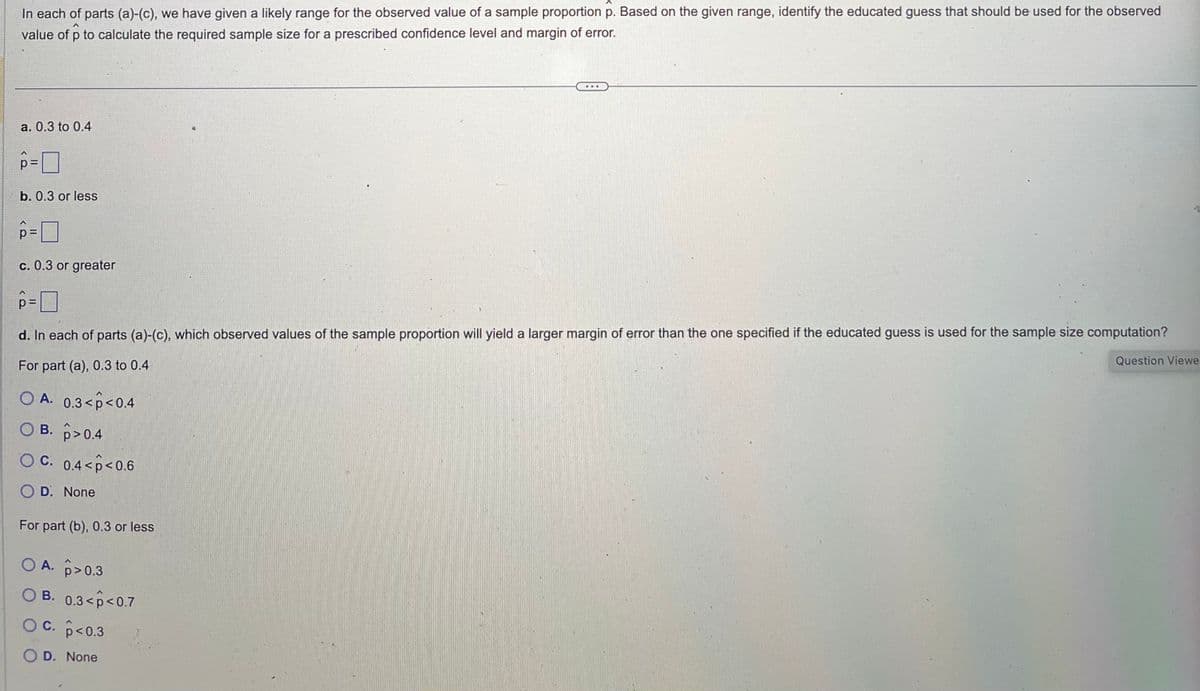In each of parts (a)-(c), we have given a likely range for the observed value of a sample proportion p. Based on the given range, identify the educated guess that should be used for the observed value of p to calculate the required sample size for a prescribed confidence level and margin of error. a. 0.3 to 0.4 b. 0.3 or less c. 0.3 or greater d. In each of parts (a)-(c), which observed values of the sample proportion Iyield a larger margin of error than the one specified if the educated guess is used for the sample size computation?
In each of parts (a)-(c), we have given a likely range for the observed value of a sample proportion p. Based on the given range, identify the educated guess that should be used for the observed value of p to calculate the required sample size for a prescribed confidence level and margin of error. a. 0.3 to 0.4 b. 0.3 or less c. 0.3 or greater d. In each of parts (a)-(c), which observed values of the sample proportion Iyield a larger margin of error than the one specified if the educated guess is used for the sample size computation?
College Algebra (MindTap Course List)
12th Edition
ISBN:9781305652231
Author:R. David Gustafson, Jeff Hughes
Publisher:R. David Gustafson, Jeff Hughes
Chapter8: Sequences, Series, And Probability
Section8.7: Probability
Problem 58E: What is meant by the sample space of an experiment?
Related questions
Question
Thanks

Transcribed Image Text:For part (c), 0.3 or greater
A. p<0.3
B. 0.3<p<0.7
OC. p>0.3
OD. None

Transcribed Image Text:In each of parts (a)-(c), we have given a likely range for the observed value of a sample proportion p. Based on the given range, identify the educated guess that should be used for the observed
value of p to calculate the required sample size for a prescribed confidence level and margin of error.
a. 0.3 to 0.4
p=
b. 0.3 or less
For part (b), 0.3 or less
...
p=0
c. 0.3 or greater
p=0
Question Viewe
d. In each of parts (a)-(c), which observed values of the sample proportion will yield a larger margin of error than the one specified if the educated guess is used for the sample size computation?
For part (a), 0.3 to 0.4
OA. 0.3<p<0.4
B. p>0.4
OC. 0.4<p<0.6
OD. None
OA. p>0.3
OB. 0.3<p<0.7
OC. p<0.3
OD. None
E
Expert Solution
This question has been solved!
Explore an expertly crafted, step-by-step solution for a thorough understanding of key concepts.
Step by step
Solved in 4 steps

Recommended textbooks for you

College Algebra (MindTap Course List)
Algebra
ISBN:
9781305652231
Author:
R. David Gustafson, Jeff Hughes
Publisher:
Cengage Learning

College Algebra (MindTap Course List)
Algebra
ISBN:
9781305652231
Author:
R. David Gustafson, Jeff Hughes
Publisher:
Cengage Learning